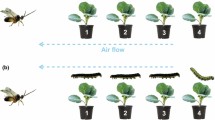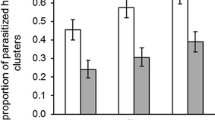Abstract
Visual cues are known to be used by numerous animal taxa to gather information on quality and location of resources. The present work was carried out to understand if visual cues are involved in host localization by E. sorbillans and if so, does an associative learning influence host localization behaviour. The Uzi fly, Exorista sorbillans Widemann is an endoparasitoid of the silkworm, Antheraea assama Westwood and a serious threat to the silk production industry in general. Associative learning in the fly was studied by using green and orange coloured paper disk in presence or absence of a reward, sugar or silk worm larvae. Training for the rewards in the learning experiment was given for 2 days for 30 min at regular intervals. Flies positively associated colored paper disks with the presence of hosts which indicated that they might employ visual learning of microhabitats associated with host habitats, or the hosts themselves. Our results showed that in context of host foraging, training with colours as host associated cues was more reliable than training with colours in the absence of hosts. Thus associative learning may be considered to be an essential component for survival of Exorista sorbillans.






Similar content being viewed by others
References
Aluja M, Prokopy RJ (1993) Host odor and visual stimulus interaction during intratree host finding behavior of Rhagoletis pomonella flies. J Chem Ecol 19:2671–2696
Alvarado PC, Barreara JF, Rojas JC (2009) Attraction of Prorops Nasuta (Hymenoptera: Bethylidae), a parasitoid of the coffee berry borer (Coleoptera: Curculionidae), to host-associated olfactory cues. Ann Entomol Soc Am 102:166–171
Arthur AP (1966) Associative learning in Itoplectis conquisitor (Hymenoptera: Ichneumonidae). Can Entomol 98:213–221
Beehler JW, Millar JG, Mulla MS (1993) Synergism between chemical attractants and visual cues influencing oviposition of the mosquito, Culex quinquefasciatus (Diptera: Culicidae). J Chem Ecol 19:635–644
Bleeker PM, Diergaarde PJ, Ament K, Guerra J, Weidner M, Schutz S, de Both MTJ, Haring MA, Schuurin RC (2009) The role of specific tomato volatiles in tomato-whitefly interaction. Plant Physiol 151:925–935
Cade W (1975) Acoustically orienting parasitoids: fly phonotaxis to cricket song. Science 190:1312–1313
Candolin U (2003) The use of multiple cues in mate choice. Biol Rev 78:575–595
Dicke M, van Loon JJA (2000) Multitrophic effects of herbivore-induced plant volatiles in an evolutionary context. Ent Exp Appl 97:237–249
Dukas R (1998) Constraints on information processing and their effects on behavior. In: Dukas R (ed) Cognitive ecology. University of Chicago Press, Chicago, pp 89–127
Feener DH Jr, Brown BV (1997) Diptera as parasitoids. Annu Rev Entomol 42:73–97
Feener DH Jr, Jacobs LF, Schmidt JO (1996) Specialized parasitoid attracted to a pheromone of ants. Anim Behav 51:61–66
Fukushi T (1985) Visual learning in walking blowflies, Lucilia cuprina. J Comp Physiol A 157:771–778
Fukushi T (1989) Colour discrimination from various shades of grey in the trained blowfly, Lucilia cuprina. J Insect Physiol 36:69–75
Ghosh CC (1949) Silk production and weaving in India, CSIR, New Delhi, 228 pp
Giurfa M, Numez J, Menzel R (1995) Colour preferences of flower-naive honey bees. J Comp Physiol 117:247–259
Godfray HCJ (1994) Parasitoids. Princeton University Press, Princeton
Goff AM, Nault LR (1984) Response of the pea aphid parasite Aphidius ervi Haliday (Hymenoptera: Aphidiidae) to transmitted light. Environ Entomol 13:595–598
Hebets EA, Papaj DR (2005) Complex signal function: developing a framework of testeable hypotheses. Behav Ecol Sociobiol 57:197–214
Ichiki RT, Kainoh Y, Yamawaki Y, Nakamura S (2011) The parasitoid fly Exorista japonica uses visual and olfactory cues to locate herbivore-infested plants. Ent Exp Appl 138:175–183
Jonsson M, Lindkvuist A, Anderson P (2005) Behavioural responses in three ichneumonid pollen beetle parasitoids to volatiles emitted from different phenological stages of oilseed rape. Ent Exp Appl 115:363–369
Kulahci IG, Dornhaus A, Papaj DR (2008) Multimodal signals enhance decision making in foraging bumble bees. Proc R Soc B 275:797–802
Leonard AS, Dornhaus A, Papaj DR (2011) Forget-me-not: complex floral displays, inter-signal interactions, and pollinator cognition. Curr Zool 57:215–224
Lopez-Guillen G, Virgen A, Rojas JC (2009) Color preference of Anastrepha oblique (Diptera: Tephritidae). Rev Bras Entomol 53:157–159
Ma RZ, Swedenborg PD, Jones RL (1992) Host-seeking behavior of Eriborus terebrans (Hymenoptera: Ichneumonidae) toward the European corn borer and the role of chemical stimuli. Ann Entomol Soc Am 85:72–79
McCall PJ, Eaton G (2001) Olfactory memory in the mosquito Culex quinquefasciatus. Med Vet Entomol 15:197–203
McNeely C, Singer MC (2001) Contrasting the roles of learning in butterflies foraging for nectar and oviposition sites. Anim Behav 61:847–852
Monteith LG (1956) Influence of host movement on selection of hosts by Drino bohemica Mesn. (Diptera: Tachinidae) as determined in an olfactometer. Can Entomol 88:583–586
Morehead SA, Feener DHJ (2000) Visual and chemical cues used in host location and acceptance by a dipteran parasitoid. J Insect Behav 13:613–625
Nakamura S (1997) Ovipositional behaviour of the parasitoid fly, Exorista japonica (Diptera: Tachinidae), in the laboratory: diel periodicity and egg distribution on a host. Appl Entomol Zool 32:189–195
Nufio CR, Papaj DR (2001) Host marking behavior in phytophagous insects and parasitoids. Ent Exp Appl 99:273–293
Oliai SE, King BH (2000) Associative learning in response to color in the parasitoid wasp, Nasonia vitripennis (Hymenoptera: Pteromalidae). J Insect Behav 13:55–69
Owens ED, Prokopy RJ (1986) Relationship between reflectance spectra of host plant surfaces and visual detection of host fruit by Rhagoletis pomonella flies. Physiol Entomol 11:297–308
Papaj DR, Prokopy RJ (1989) Ecological and evolutionary aspects of learning in phytophagous insects. Annu Rev Entomol 34:315–350
Parmesan C, Singer MC, Harris I (1995) Absence of adaptive learning from the oviposition foraging behaviour of a checkerspot butterfly. Anim Behav 50:161–175
Prokopy RJ, Owens ED (1983) Visual detection of plants by herbivorous insects. Annu Rev Entomol 28:337–364
Prokopy RJ, Moericke V, Bush GL (1973) Attraction of apple maggot flies to odor of apples. Environ Entomol 2:743–749
Romeis J, Shanower TG, Zebitz CPW (1998) Response of Trichogramma egg parasitoids to colored sticky traps. BioControl 43:17–27
Roth JP, King EG, Thompson AC (1978) Host location behavior by the tachinid, Lixophaga diatraeae. Environ Entomol 7:794–798(5)
Roth JP, King EG, Hensley SD (1982) Plant, host, and parasite interactions in the host selection sequence of the tachinid Lixophaga diatraeae. Environ Entomol 11:273–277
Rowe C (1999) Receiver psychology and the evolution of multicomponent signals. Anim Behav 58:921–931
Shafir S (1996) Color discrimination of the wasp, Polybia occidentalis (Hymenoptera: Vespidae). Biotropica 28:243–251
Singer MC, Thomas CD (1996) Evolutionary responses of a butterfly metapopulation to human and climate-caused environmental variation. Am Nat 148:S9–S39
Steidle JLM, Van Loon JJA (2003) Dietary specialization and infochemical use in carnivorous arthropods: testing a concept. Ent Exp Appl 108:133–148
Stireman JO III (2002a) Learning in the generalist tachinid parasitoid Exorista Mella Walker (Diptera: Tachinidae). J Insect Behav 15(5):689–706
Stireman JO III (2002b) Host location and selection cues in a generalist tachinid parasitoid. Ent Exp Appl 103:23–34
Tanaka C, Kainoh Y, Honda H (1999) Comparison of oviposition on host larvae and rubber tubes by Exorista japonica townsend (Diptera: Tachinidae). Biol Control 14:7–10
Tinbergen N (1984) Curious Naturalists. Revised edition. University of Massachusetts Press
Tomberlin J, Rains G, Allan S, Sanford M, Lewis W (2006) Associative learning of odor with food or blood-meal by Culex quinquefasciatus Say (Diptera: Culicidae). Naturwissenschaften 93:551–556
Van Driesche RG, Murray TJ (2004) Overview of testing schemes and designs used to estimate host ranges. In: Van Driesche RG, Reardon R (eds) Assessing host ranges for parasitoids and predators used for classical biological control: a guide to best practice. USDA Forest Service, Morgantown, pp 68–89
van Lenteren JC (1981) Host discrimination by parasitoids. In: Nordlund DA, Jones RL, Lewis WJ (eds) Semiochemicals: their role in pest control. John Wiley and Sons, New York, pp 153–179
Vinson SB (1984) How parasitoids locate their hosts: a case of insect espionage. In: Lewis T (ed) Insect communication. Royal Entomological Society of London, London, pp 325–348
Vinson SB (1985) The behaviour of parasitoids. In comprehensive insect physiology, biochemistry and pharmacology. In: Kerkut GA, Gilbert LI (eds) Behaviour, vol 9. Pergamon press, New York, pp 417–469
Wackers FL, Lewis WJ (1999) A comparison of color, shape and pattern learning by the hymenopteran parasitoid Microplitis croceipes. J Comp Physiol 184:387–393
Walker TJ (1993) Phonotaxis in female Ormia ochracea (Diptera: Tachinidae), a parasitoid of field crickets. J Insect Behav 6:389–410
Wardle AR (1990) Learning of host microhabitat colour by Exercistes roborator (F.) (Hymenoptera: Ichneumonidae). Ann Behav 39:914–923
Weiss M (1997) Innate colour preferences and flexible colour learning in the pipevine swallowtail. Anim Behav 53:1043–1052
Weseloh RM (1974) Host recognition by the gypsy moth larval parasitoid, Apanteles melanoscelus. Ann Entomol Soc Am 67:583–587
Yamawaki Y, Kainoh Y (2005) Visual recognition of the host in the parasitoid fly Exorista japonica. Zool Sci 22(5):563–570
Yamawaki Y, Kainoh Y, Honda H (2002) Visual control of host pursuit in the parasitoid fly Exorista japonica. J Exp Biol 205:485–492
Acknowledgement
The authors are grateful to Department of Science and Technology, New Delhi, India for financial grant through the project SR/SO/AS-77/2006. Authors are also grateful to the two anonymous reviewers for their helpful comments on the manuscript.
Author information
Authors and Affiliations
Corresponding author
Rights and permissions
About this article
Cite this article
Bora, D., Deka, B. Role of Visual Cues in Host Searching Behaviour of Exorista sorbillans Widemann, a Parasitoid of Muga Silk Worm, Antheraea assama Westwood. J Insect Behav 27, 92–104 (2014). https://doi.org/10.1007/s10905-013-9409-1
Revised:
Accepted:
Published:
Issue Date:
DOI: https://doi.org/10.1007/s10905-013-9409-1




